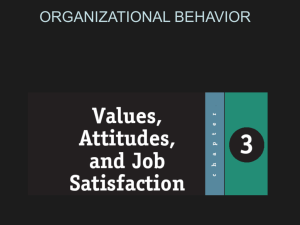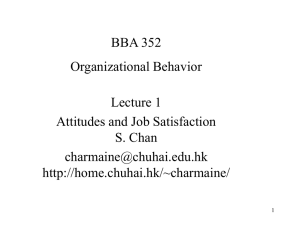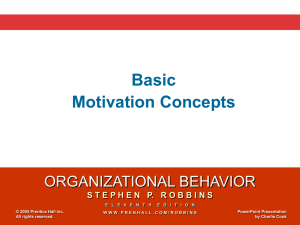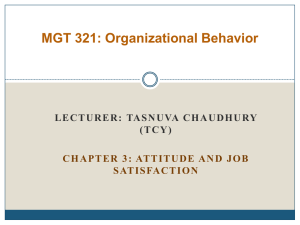ORGANIZATIONAL BEHAVIOR
advertisement
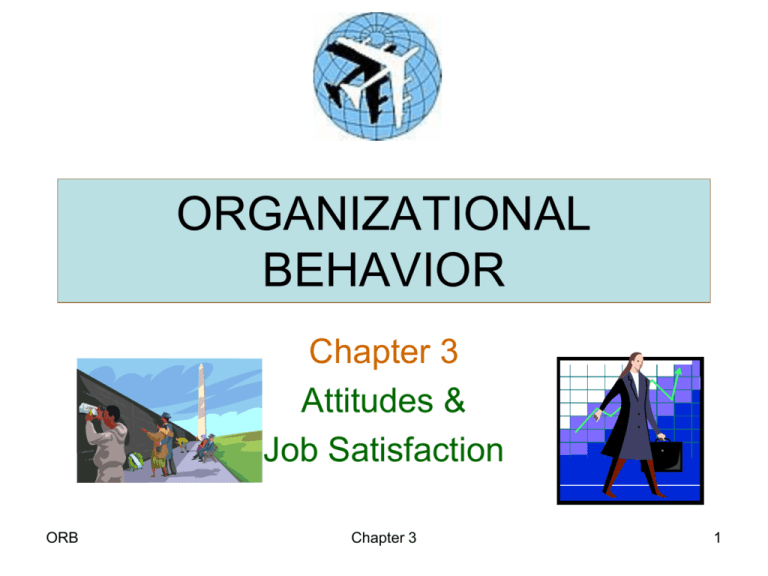
ORGANIZATIONAL BEHAVIOR Chapter 3 Attitudes & Job Satisfaction ORB Chapter 3 1 Attitudes Attitudes Evaluative statements or judgments concerning objects, people, or events Cognitive Component The opinion or belief segment of an attitude Affective Component The emotional or feeling segment of an attitude Behavioral Component An intention to behave in a certain way toward someone or something ORB Chapter 3 2 The Theory of Cognitive Dissonance Cognitive Dissonance Any incompatibility between two or more attitudes or between behavior and attitudes Individuals seek to reduce this gap, or “dissonance” Cheating in your income tax, pouted river and air Desire to reduce dissonance depends on: • Importance of elements creating dissonance • Degree of individual influence over elements • Rewards involved in dissonance ORB Chapter 3 3 Types of Attitudes Job Satisfaction A collection of positive and/or negative feelings that an individual holds toward his or her job resulting from an evaluation of its characteristics. Job Involvement The degree to which a person identifies with a job, actively participate in it, and consider performance important to self-worth. Organizational Commitment Defined as a state in which an employee Identifies with a particular organization and its goals, and wishing to maintain membership in the organization (Affective, Normative, and Continuance Commitment) ORB Chapter 3 4 Types of Attitudes • Organizational Commitment – Affective commitment – an emotional attachment to an organization and a belief in its values – Continuance commitment – the perceived economic value of remaining with an organization compared to leaving it. – Normative commitment – an obligation to remain with organization for moral or ethical reasons. ORB Chapter 3 5 Types of Attitudes Perceived Organizational Support (POS) Degree to which employees feel the organization cares about their well-being Employee Engagement An individual’s involvement with, satisfaction with, and enthusiasm for the organization ORB Chapter 3 6 An Application: Attitude Surveys Attitude Surveys Eliciting responses from employees through questionnaires about how they feel about their jobs, work groups, supervisors, and the organization ORB Chapter 3 7 Attitudes and Workforce Diversity • Training activities that can reshape employee attitudes concerning diversity: – Participating in diversity training that provides for self-evaluation and group discussions ORB Chapter 3 8 Causes of Job Satisfaction • Pay influences job satisfaction only to a point. – After about $40,000 a year, there is no relationship between amount of pay and job satisfaction. • Personality can influence job satisfaction. – Negative people are usually not satisfied with their jobs. ORB Chapter 3 9 How Employees Can Express Dissatisfaction Exit Voice Behavior directed toward leaving the organization Active and constructive attempts to improve conditions ORB Loyalty Neglect Passively waiting for conditions to improve Allowing conditions to worsen absenteeism, reduced effort Chapter 3 10 The Effect of Job Satisfaction on Employee Performance • Satisfaction and Productivity – Satisfied workers are more productive AND more productive workers are more satisfied! – Worker productivity is higher in organizations with more satisfied workers. • Satisfaction and Absenteeism – Satisfied employees have fewer avoidable absences. • Satisfaction and Turnover – Satisfied employees are less likely to quit. – Organizations take actions to retain high performers and to weed out lower performers. ORB Chapter 3 11 Job Satisfaction and OCB • Satisfaction and OCBs – Satisfied employees who feel fairly treated by and are trusting of the organization are more willing to engage in behaviors that go beyond the normal expectations of their job. ORB Chapter 3 12 Job Satisfaction and Customer Satisfaction • Satisfaction and Customer Satisfaction – Satisfied workers provide better customer service. • Satisfied employees increase customer satisfaction because: – They are more friendly, upbeat, and responsive. – They are less likely to turnover, which helps build long-term customer relationships. – They are experienced. • Dissatisfied customers increase employee job dissatisfaction. ORB Chapter 3 13
